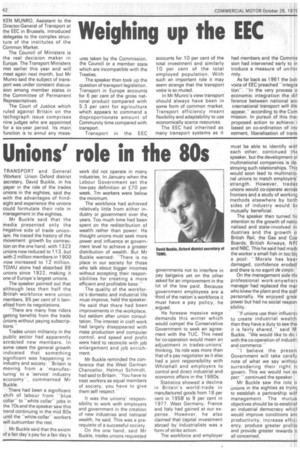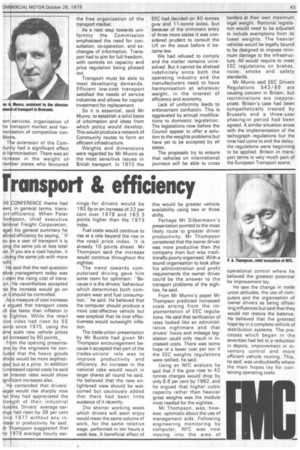Weighing up the EEC
Page 44

Page 45

If you've noticed an error in this article please click here to report it so we can fix it.
KEN MUNRO, Assistant to the Director-General of Transport at the EEC in Brussels, introduced delegates to the complex structure of the institutes of the Common Market.
The Council of Ministers is the real decision maker in Europe. The Transport Ministers met earlier this year and will meet again next month, but Mr Munro said the subject of transport was under constant discussion among member states in the Committee of Permanent Representatives.
The Court of Justice which ruled against Britain on the tachograph issue comprises nine judges who are appointed, for a six-year period. Its main, function is to annul any meas
ures taken by the Commission, the Council or a member state which are incompatible with the Treaties.
The speaker then took up the question of transport legislation. Transport in Europe accounts for 6 per cent of the gross national product compared with 5.3 per cent for agriculture which appears to command a disproportionate amount of Community time compared with. transport.
Transport in the EEC accounts for 10 per cent of the total investment and similarly 10 per cent of the total employed population. With such an important role it may seem strange that the transport voice is so muted.
In Mr Munro's view transport should always have been in some form of common market. Transport efficiency meant flexibility and adaptability to use economically scarce resources.
The EEC had inherited as many transport systems as it had members and the Commis sion had intervened early to in troduce a measure of unifor mity.
As far back as 1961 the bolE voice of EEC preached "integra tion". "In the very process o economic integration the dif ference between national an international transport will dis appear," according to the Corn mission. In pursuit of this the proposed action to achieve i based on co-ordination of inv estment, liberalisation of trans
)ort services, organisation of he ransport market and harnon sation of competitive coniitio s.
e extension of the Cornnun ty had a significant effect h rmonisation. There was an ner ase in the weight of ne ber states who favoured the free organisation of the transport market.
As a next step towards uniformity the Commission emphasised the need for consultation, co-operation, and exchanges of information. Transport had to aim for full freedom, with controls on capacity and price regulation being phased out.
Transport must be able to meet developing demands. Efficient low-cost transport satisfied the needs of service industries and allows for capital investment for replacement.
So it is essential, said Mr Munro, to establish a solid basis of information and ideas from which policy would develop. This would produce a network of Community routes to form an efficient infrastructure.
Weights and dimensions were regarded by Mr Munro as the most sensitive issues in British transport. In 1972 the EEC had decided on 40 tonnes gvw and 11-tonne axles, but because of the imminent entry of three more states it was considered prudent to consult the UK on the issue before it became law.
We had refused to comply and the matter remains unresolved. But it cannot be shelved indefinitely since both the operating industry and the manufacturers need to have harmonisation at whatever weight, in the interest of efficiency and economy.
Lack of uniformity leads to enforcement confusion. This is aggravated by annual modifications to domestic legislation. The legislations now before the Council appear to offer a solution to the weights problems but have yet to be accepted by all states.
The proposals try to ensure that vehicles on international journeys will be able to cross borders at their own maximum legal weight. National legislation would need to be adjusted to include exemptions from its lower weights. The heavier vehicles would be legally bound to be designed to impose minimum damage to the infrastructure. All would require to meet EEC regulations on brakes, noise, smoke and safety standards.
Mr Munro said EEC Drivers Regulations 543/69 are causing concern in Britain, but recriminations are inappropriate. Britain's case had been sympathetically treated by Brussels and a three-year phasing-in period had been agreed. A similar situation arose with the implementation of the tachograph regulations but the time had come to end the delay: the regulations were beginning to be applied. Britain in transport terms is very much part of the European Transport scene,
























































































































